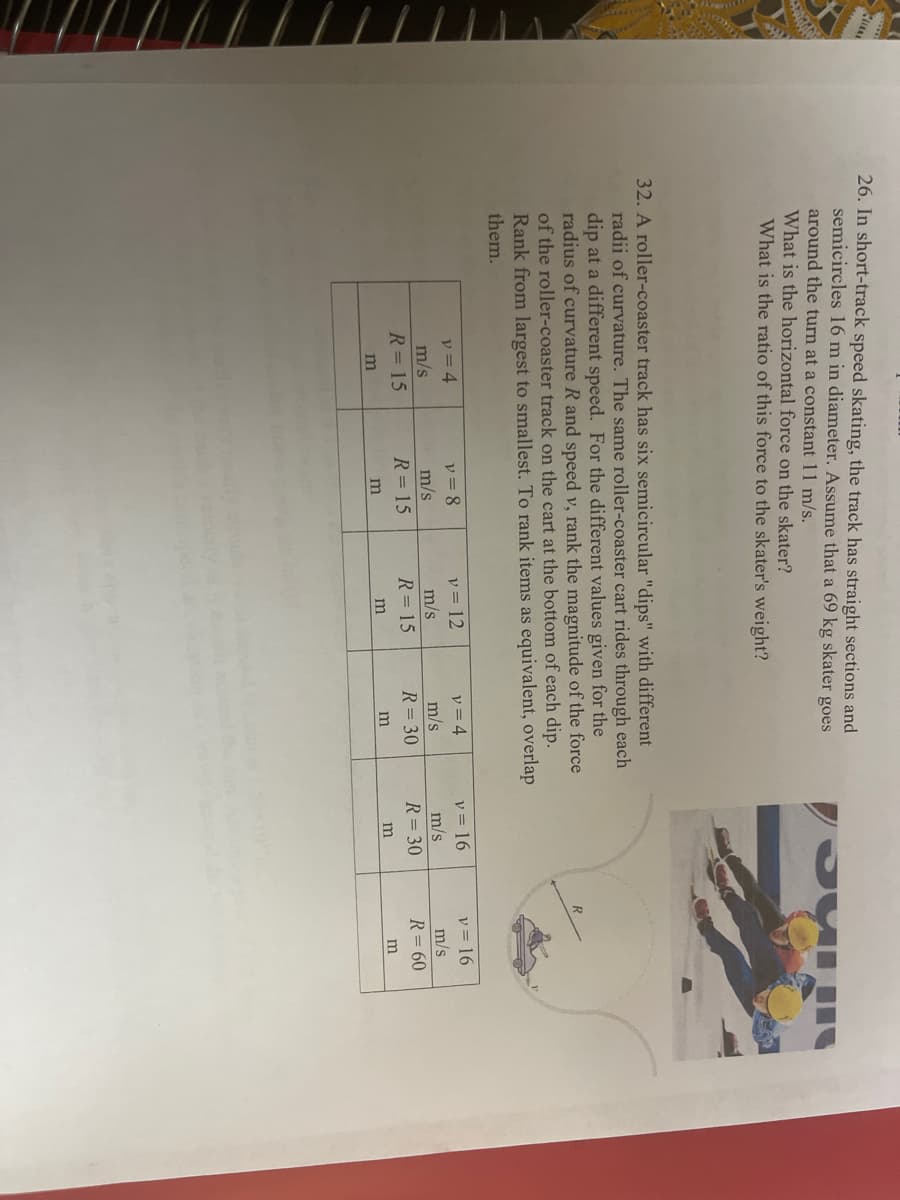In short-track speed skating, the track has straight sections and semicircles 16 m in diameter. Assume that a 69 kg skater goes around the turn at a constant 11 m/s. What is the horizontal force on the skater? What is the ratio of this force to the skater's weight?
In short-track speed skating, the track has straight sections and semicircles 16 m in diameter. Assume that a 69 kg skater goes around the turn at a constant 11 m/s. What is the horizontal force on the skater? What is the ratio of this force to the skater's weight?
College Physics
11th Edition
ISBN:9781305952300
Author:Raymond A. Serway, Chris Vuille
Publisher:Raymond A. Serway, Chris Vuille
Chapter7: Rotational Motion And Gravitation
Section: Chapter Questions
Problem 58AP: A roller coaster travels in a circular path, (a) Identify the forces on a passenger at the top of...
Related questions
Topic Video
Question
Number 26

Transcribed Image Text:26. In short-track speed skating, the track has straight sections and
semicircles 16 m in diameter. Assume that a 69 kg skater goes
around the turn at a constant 11 m/s.
What is the horizontal force on the skater?
What is the ratio of this force to the skater's weight?
32. A roller-coaster track has six semicircular "dips" with different
radii of curvature. The same roller-coaster cart rides through each
dip at a different speed. For the different values given for the
radius of curvature R and speed v, rank the magnitude of the force
of the roller-coaster track on the cart at the bottom of each dip.
Rank from largest to smallest. To rank items as equivalent, overlap
them.
v = 4
m/s
v = 4
レ=8
m/s
v = 12
v = 16
v = 16
m/s
R= 15
m/s
m/s
m/s
R= 15
R= 15
R= 30
R= 30
R= 60
m
m
Expert Solution
This question has been solved!
Explore an expertly crafted, step-by-step solution for a thorough understanding of key concepts.
This is a popular solution!
Trending now
This is a popular solution!
Step by step
Solved in 3 steps with 4 images

Knowledge Booster
Learn more about
Need a deep-dive on the concept behind this application? Look no further. Learn more about this topic, physics and related others by exploring similar questions and additional content below.Recommended textbooks for you

College Physics
Physics
ISBN:
9781305952300
Author:
Raymond A. Serway, Chris Vuille
Publisher:
Cengage Learning

Principles of Physics: A Calculus-Based Text
Physics
ISBN:
9781133104261
Author:
Raymond A. Serway, John W. Jewett
Publisher:
Cengage Learning

College Physics
Physics
ISBN:
9781938168000
Author:
Paul Peter Urone, Roger Hinrichs
Publisher:
OpenStax College

College Physics
Physics
ISBN:
9781305952300
Author:
Raymond A. Serway, Chris Vuille
Publisher:
Cengage Learning

Principles of Physics: A Calculus-Based Text
Physics
ISBN:
9781133104261
Author:
Raymond A. Serway, John W. Jewett
Publisher:
Cengage Learning

College Physics
Physics
ISBN:
9781938168000
Author:
Paul Peter Urone, Roger Hinrichs
Publisher:
OpenStax College

College Physics
Physics
ISBN:
9781285737027
Author:
Raymond A. Serway, Chris Vuille
Publisher:
Cengage Learning


Physics for Scientists and Engineers, Technology …
Physics
ISBN:
9781305116399
Author:
Raymond A. Serway, John W. Jewett
Publisher:
Cengage Learning